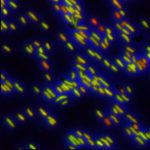Lien vers Pubmed [PMID] – 18359296
Lien DOI – 10.1016/j.biochi.2008.03.005
Biochimie 2008 May; 90(5): 679-85
O-GlcNAc glycosylations on serines or threonines are reversible post-translational modifications that control the localisation, the activity or the stability of cytosolic and nuclear proteins. These dynamic modifications are tightly dependent on the availability of glucose and on its flux through the hexosamine biosynthetic pathway. We recently showed that treatments that increase protein O-GlcNAc glycosylation (high-glucose concentrations, glucosamine) or inhibit their deglycosylation (PUGNAc), induced O-GlcNAc modification of FoxO1 in HEK293 cells. O-GlcNAc glycosylation of FoxO1 resulted in an increased of its activity towards a glucose 6-phosphatase promoter-luciferase reporter gene (G6Pase-luc). This effect appeared to be independent of FoxO1 sub-cellular re-localisation, since it was also observed with the constitutively nuclear FoxO1-AAA mutant. In liver-derived HepG2 cells, glucosamine and PUGNAc increased the expression of G6Pase mRNA, and synergistic effects were observed when both agents were present together. In addition, the expression of PGC1 alpha gene, which is known to be under the control of FoxO1, was also increased by glucosamine and PUGNAc. In HepG2 cells stably expressing the G6Pase-luc reporter gene, glucosamine and PUGNAc also increased the activity of the G6Pase promoter. The stimulation of the G6Pase reporter gene by these agents was abolished by two different FoxO1 siRNAs, thereby demonstrating the involvement of endogenous FoxO1 in the observed effects. Since G6Pase plays a key role in glucose production by the liver, increased in its expression through FoxO1 O-GlcNAc modification may be of considerable importance in the context of glucotoxicity associated with chronic hyperglycaemia. Moreover, since FoxO1 also plays important roles in several aspects of cell biology, including cell proliferation, survival and apoptosis, the regulation of FoxO1 activity by O-GlcNAc modification may have implications for other crucial biological processes.

